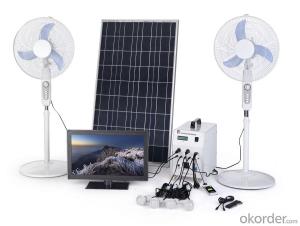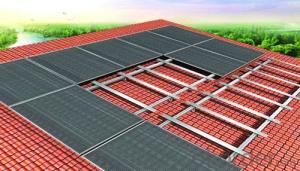Solar Energy Systems - Solar Mounting Tile-On Roof System PNG
- Loading Port:
- China Main Port
- Payment Terms:
- TT OR LC
- Min Order Qty:
- -
- Supply Capability:
- -
OKorder Service Pledge
OKorder Financial Service
You Might Also Like
Product Features
• Widely used for both crystalline and thin film modules.
• Easy & quick installation.
• Only 4~5 kinds of components and no more than three kinds of tools in whole system fixation.
• All system components are made with high quality aluminum & stainless steel.
Technical Data
Project site Sloped roof tile
Tile type Wave, trapezoidal, and various upright side whipstitch forms of caigang watts
Slope of roof On request
Roof specification Frame / frameless module, crystalline/ thin film module
Installation type fixation on the roof
Module arrangement Portrait Landscape
Module area square Client requirement
Module area position Client requirement
Roof structure Client requirement
Loading section Al 6063 T5
Roof hook Stainless steel
Small pieces Stainless steel, Al6063 T5
- Q: Can solar energy systems be used in areas with limited access to electricity?
- Yes, solar energy systems can be used in areas with limited access to electricity. Solar energy systems are designed to harness the power of the sun and convert it into electricity, making them a viable solution for areas without a reliable electricity grid. They can be installed in remote locations, off-grid communities, or areas with limited infrastructure, providing a clean and sustainable source of energy. Additionally, advancements in solar technology have made it more affordable and efficient, making it a practical option for areas with limited access to electricity.
- Q: Can solar energy systems be integrated with battery storage?
- Yes, solar energy systems can be integrated with battery storage. Battery storage allows excess solar energy generated during the day to be stored for use during times when the sun is not shining, such as at night or during cloudy weather. This integration enhances the reliability and efficiency of solar energy systems by providing a continuous and reliable source of electricity.
- Q: Can solar energy systems be used for heating swimming pools?
- Yes, solar energy systems can be used for heating swimming pools. Solar thermal systems are specifically designed to collect and harness the sun's heat, which can then be used to warm water in swimming pools. These systems are cost-effective, environmentally friendly, and can significantly reduce energy consumption compared to traditional heating methods.
- Q: Are solar energy systems suitable for residential use?
- Yes, solar energy systems are suitable for residential use. They are a clean and renewable source of energy that can reduce electricity bills, decrease dependence on the grid, and contribute to a more sustainable and environmentally friendly lifestyle. With advancements in technology and decreasing costs, solar energy systems have become more accessible and efficient, making them a viable option for residential properties.
- Q: Are there any environmental benefits to using solar energy systems?
- Yes, there are several environmental benefits to using solar energy systems. Firstly, solar energy is a clean and renewable source of power, which means it does not release harmful pollutants or greenhouse gases into the atmosphere, unlike fossil fuels. By reducing our reliance on coal, oil, and natural gas, solar energy helps to mitigate climate change and improve air quality. Additionally, solar panels do not require water for operation, unlike traditional power plants, conserving this precious resource. Overall, solar energy systems offer a sustainable and environmentally friendly solution to meeting our energy needs.
- Q: Can solar energy systems be used in areas with limited access to reliable internet connection?
- Yes, solar energy systems can be used in areas with limited access to reliable internet connection. Solar energy systems function independently of internet connectivity as they generate electricity from sunlight using photovoltaic panels. The generated power can be stored in batteries or used directly to power various devices and appliances, regardless of an internet connection.
- Q: Can solar energy systems be integrated into building design?
- Yes, solar energy systems can definitely be integrated into building design. In fact, solar panels and other solar technologies are commonly incorporated into the design and construction of modern buildings. This integration allows for the generation of clean and renewable energy on-site and reduces dependence on traditional energy sources. Additionally, integrating solar energy systems into building design can help reduce greenhouse gas emissions and contribute to a more sustainable and environmentally friendly future.
- Q: Can solar energy systems be installed in any location?
- Solar energy systems can be installed in most locations, as long as there is sufficient sunlight available. However, the efficiency and effectiveness of the system may vary depending on factors such as the amount of sunlight, shading, and the available roof or ground space for installation.
- Q: How do solar energy systems impact wildlife habitats?
- Solar energy systems can have both positive and negative impacts on wildlife habitats. On the positive side, these systems do not emit greenhouse gases, reducing air pollution and mitigating climate change, which can benefit wildlife in the long run. Moreover, solar panels can be installed on rooftops or in non-intrusive areas, minimizing disturbance to wildlife habitats. However, large-scale solar projects can disrupt ecosystems by clearing land or displacing wildlife. Therefore, careful planning and implementation of solar energy systems are crucial to minimize negative impacts on wildlife habitats.
- Q: How does the angle of the sun affect the performance of a solar energy system?
- The angle of the sun directly affects the performance of a solar energy system. When the sun is at a higher angle or directly overhead, the solar panels receive more direct sunlight, resulting in increased energy production. Conversely, when the sun is at a lower angle or obscured by clouds, the solar panels receive less direct sunlight, leading to decreased energy production. Therefore, optimizing the angle and orientation of solar panels is crucial for maximizing the efficiency and output of a solar energy system.
Send your message to us
Solar Energy Systems - Solar Mounting Tile-On Roof System PNG
- Loading Port:
- China Main Port
- Payment Terms:
- TT OR LC
- Min Order Qty:
- -
- Supply Capability:
- -
OKorder Service Pledge
OKorder Financial Service
Similar products
Hot products
Hot Searches
Related keywords






























